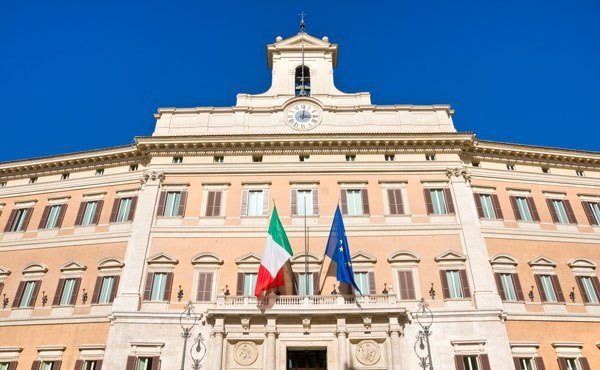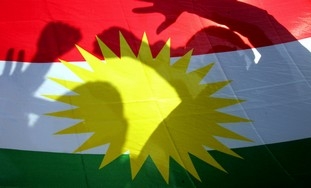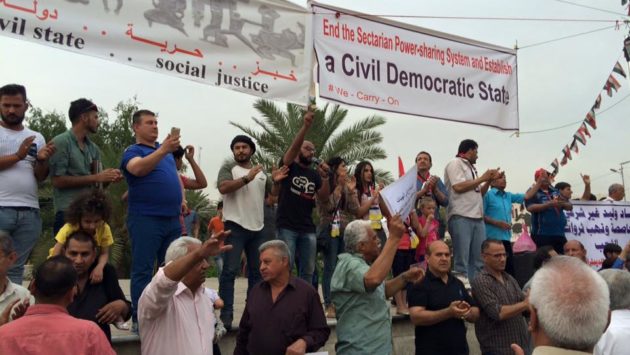Behind the Peaceful Protests: Cultural Transformation in Iraq
ICSSI Intervention in a hearing about Iraq before the Italian Foreign affairs commission
Rome – January 2020
In the streets and public squares
For over three months, Iraq has witnessed a powerful and widespread popular movement, one that is challenging the 2003, post-US invasion political regime. What is happening in the public squares of the main Iraqi cities is more than simply a “revolt” against corruption or against the failed promises of the political system as a whole. Far more than a mere “regime change”, Iraq seems to be undergoing a profound cultural and social transformation.
This protest movement began on 1 October 2019, and spread quickly throughout all of central and southern Iraq, to 10 out of 18 provinces (governorates), including those of Iraqi Kurdistan. It is a movement led primarily by young people and represents a continuation of the protests that took place in Iraq beginning in 2003. For more than 15 years, people have been speaking out about the lack of work and the scarcity of services, against widespread corruption and the political regime imposed on the country in 2003. There were protests in 2010, 2011, 2015, and 2018 … but the current protest is somehow different.
Despite enormous external pressures, despite the exhausting work that has already cost many human lives, Iraqi youth continue to communicate and to organize, to spread and exchange information about the many protest activities through social media. Government data cites 480 dead but others estimate the total is at least 600; the injured number over 20,000. Nevertheless, students — male and female — are courageously facing these sacrifices head on. They are committed to the protest and seem unwilling to stop until their demands are met.
This sweeping youth movement is primarily composed of people born in a distinctly different Iraq from that of the 80s and 90s. They don’t know the fear of dictatorship like previous generations. Furthermore, this generation has been continually accused of being incompetent and ineffective, of being unable to bring about real change, of being more interested in their cell phones than in political justice.
But this is a misconception. In fact, this generation is moved by a powerful energy, expressed in the slogan “We can do it and we are not afraid”. Young men and women, their bare hands holding only an Iraqi flag and a cell phone, throw themselves into confrontations, some have been killed, some even filmed their own deaths or those of their friends. They are of that age when they are willing to give everything they have for a cause that inspires them.
In an Iraq where political parties claim to speak on behalf of this or that particular ethnicity or religion, these youth respond that they do not want to be labeled Sunni, Shi’ite, or anything else. They are Iraqis, plain and simple, and this kind of sectarian politics does not represent them. This is why they are not afraid to demonstrate in front of the Iranian consulates, even after seeing their friends, brothers, sisters, and acquaintances killed by the police. They will not be intimidated, nor deterred from tearing the Iranian flag from the facade of a building, from trying to occupy the consulate, even in cases when these same consulates were burned. And let us be clear, young people have been killed for this, in Najaf and in Nasiriyah.
Yet even in light of the very real dangers they face, they repeat “You don’t represent us”, reaffirming again and again their Iraqi identity over any divisive sectarian one.
Hundreds of tents have been set up by peaceful demonstrators in Iraq’s public squares, in particular in Tahrir Square in Baghdad. Different tents have different meanings and have been organized by different groups. Some tents have been set up by professional associations and unions, where specific issues are addressed; legal issues, for instance, are addressed in the attorney tent. Here, people might come for help with issues relating to arrests or disappearances. Others tents deal with logistical issues such as keeping the square and streets where demonstrations take place clean. Whoever is organizing this has managed to make an effective campaign on the collection of waste.
An interesting example of an ecological and issue-oriented tent is one called “Let’s Save the Tigris”, which has organized effective cleaning of the Tigris River beaches. We should remember that Tahrir Square overlooks the Tigris River on one side; just opposite – on the other side – is the “Green Zone” where the palaces of power are located. Even from the edge of Tahrir Square, which is closest to the river bank, for years it has been impossible to go down to the river due to the dirt, insecurity, other restrictions. Peaceful protesters have changed all this in a matter of months, cleaning up and inaugurating “Tahrir Beach” where volleyball games along with other sports and recreational activities are now organized.
There are other important tents such as the one that provides medical assistance, with essential help from the drivers of Tuk-tuks, three-wheeled vehicles that operate throughout Baghdad. These drivers have volunteered their time since the start of the demonstrations, acting as improvised ambulances, now symbols of revolt.
Some tents are organized by students on behalf of their schools and universities, in this kind of tent discussions take place about the protests and conditions at schools.
And there are dozens of catering tents that offer free food, thanks to countless generous donations from the residents of Baghdad who manage to feed thousands of people every day. We might note here the example of a famous chef – Abu Aloosh – who has organized a food tent that streams its daily activities of preparing food on Facebook.
Other tents play a role in coordinating discussion. For example, the tent, “Another Iraq is Possible”, organized by the Iraqi Social Forum, offers people an opportunity to take part in critical political discussions, addressing key issues such as: the next elections, the qualities and qualifications of the next prime minister. Themes for these discussions arise from different tents in the square.

The political process and the revolt
From public squares around Iraq, protesters are calling for a new independent government that can move through a period of transition from the current regime to another political system: including a new electoral law that will guarantee the possibility of candidates who are independent from existing parties and a truly independent electoral commission, not based on a sectarian structure as the current one is. Over the past few days and under pressure from protesters, the government of Abdul Mahdi, though he has resigned, has passed a new electoral law and formed a new electoral commission consisting of nine magistrates from all over Iraq.
For the moment, it seems unlikely that a new political force will arise from the protests. There is a great deal of fear surrounding this moment because in 2018 the “Saairun” coalition — formed by the Sadrists of Muqtada el Sadr and the communists — was thought to be precisely this, a true “representation” of the previous wave of popular protests. But in just a year, it failed miserably. Despite being the largest electoral block, the Saairun coalition decided to ally with a block of Shi’ite militias to form a government, and together they agreed on Prime Minister Adil Abdul Mahdi. They were given a year to bring about change, but this did not happen. Instead, Abdul Mahdi protected the political leaders and corrupt officials from all parties. This recent history weighs heavily on the minds of current protesters, and explains why there is such reticence about confining this great movement to a single, formal political and legislative formula.
The conflict with Iran
The US attack, ordered directly by Donald Trump, which killed the Iranian general Suleymani, is likely to change radically the nature of relations among countries within the larger region. The consequences will certainly be felt in Iraq, a country where Iran has played a decisive role and where General Suleymani exercised direct control.
Iran’s response to the US bombing of the “Ain al Assad” military bases in Anbar and “Al-harir” near Erbil has been measured, and there appears to be some kind of agreement between the US and Iran not to go to war openly. However, the conflict between the two persists as a threat to peace in the region: Trump’s strategy of “Maximum Pressure” and economic sanctions does not leave the regime in Iran with much room to manouvre, and thus may cause it to collapse into violence. For its part, the Iranian regime has decided to respond to America’s aggression in Iraq through its militias, already active in the region.
All this threatens to overshadow the massive, peaceful, popular demonstrations that have mobilized the Iraqi people across the entire country and continued now for more than three months. This mobilization calls into question the political regime that developed following the US invasion of 2003. In recent years, the world has talked almost exclusively of the Iran’s role in the region and in particular of the role of the Iranian “super general” Suleymani who commanded in Iraq and played such a large role in deciding issues of Iraqi politics.
The Iraqi youth who are the engine behind the protests want to make it clear that Iraq is an autonomous nation, with its own history, identity, and sovereignty. “We are not Shi’ites who can be ruled by Iran; nor are we a country that must represent the interests of Trump and his friends in the Middle East.”
Why this revolt is so important and so extraordinary
This movement, though in key respects a continuation of past movements with similar aims, represents a qualitatively different kind of cultural moment and opportunity.
First, those involved have revealed a remarkable a capacity for organization, self-management, and an ability to maintain orderly and effective protests over an extended period of time.
Second, the protesters have shown an exceptional ability to maintain the nonviolent nature of their movement, even in the face of many provocations, of spilled blood, and while mourning the senseless loss of family and loved ones. These young protesters have had the courage to stand up to extremely dangerous actors, including armed militias, the powerful Ashira tribes who confronted peaceful protesters with weapons, faceless snipers shooting from the rooftops of buildings, and taunts by those who call them dangerous terrorists like Daesh.
Third, women have played a leading role in the movement. And this is a huge cultural change, an historic transformation.
These three elements are monumental, important for the Iraqi people and indeed, for the whole Mashrek; they will profoundly change the history of Iraq, as the French Revolution changed Europe.
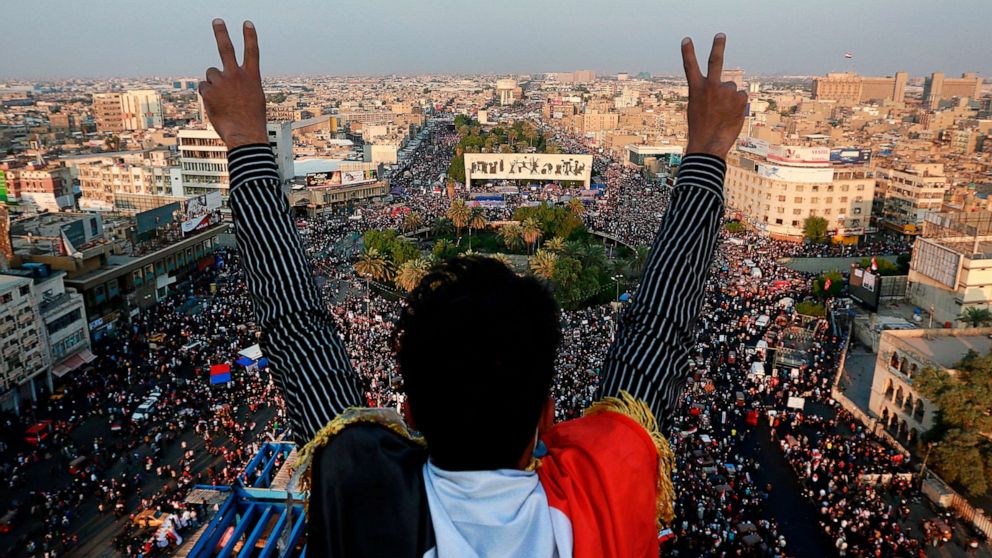
What do the voices from Tahrir Square ask of Italy and Europe?
A) Italy and Europe could pressure the Iraqi president and the current government to ensure that the rights of demonstrators will be protected:
The Iraqi government must respect its constitutional and international obligations to protect freedom of assembly and freedom of expression.
In particular, it must:
- order the police and security forces to stop any excessive use of force, starting with lethal force against demonstrators.
- ensure that all human rights defenders and the media are able to operate without restrictions, including judicial harassment.
- fully respect freedom of the press and guarantee that there will be no further attacks on journalists and media offices.
- end the arbitrary arrest and detention of peaceful demonstrators and human rights defenders, some of whom have been beaten.
- immediately and unconditionally release all peaceful demonstrators who have been arrested and provide medical care to all those who need it.
- conduct independent, impartial and thorough investigations into all cases of use of excessive and lethal force by state and non-state actors.
- publicly disseminate the results of the investigations and bring those responsible to justice according to the highest standards of international law.
B) Italian and European intervention in Iraq
To this day, Iraqis still distinguish between the disruptive and damaging role played by both the US and Iran in Iraq, as opposed to the far more acceptable one possible for the United Nations and the European Union to play; for this reason they strongly reject any interference by the US and Iran in Iraqi affairs.
This point is critical as it allows for some actors, including Italy, to play a positive role in Iraq. Possible interventions might include:
- Italy and Europe could assist the (formal) Electoral Commission and civil society in monitoring the upcoming elections in Iraq.
- Italy, together with other countries that train police forces, could provide trainings for Iraqi police that prioritize above all else respect for human rights and the use of nonviolent measures for crowd containment. Respect for human rights should not be an “accessory” part of police training as it is now!
- Italy could play an important role in the protection of the cultural heritage in Nasiriyah and Ur in particular and throughout all of Iraq more generally by providing trainings for the police designated to protect archeological sites and other cultural projects, and for members of civil society.
- Italy and Europe could play a greater role in supporting, training and empowering civil society.
C) The geopolitical level
We know that there is now an ongoing discussion about establishing a new NATO mission to replace the current anti-Daesh coalition. This seems to us to be a mistake because it confuses the role of Europeans with that of the US, and reduces the former to a purely a military relationship. The more soldiers there are on one side, the more soldiers will inevitably turn up on the other. It is critical to reiterate that the peaceful demonstrators in Iraq’s public squares are calling for an end to a division of power along sectarian lines, that is to say they reject the basis of the government initially imposed by US occupiers and then maintained afterwards by Iran.
In contrast to these corrupted and damaging relations which tend only towards more violence and bloodshed, Italy could lead Europe in offering support for Iraqi peace and independence, actively helping to turn it away from the war and conflict that now characterize its dealings with the US and Iran.
The current military mission might then be radically transformed into a civilian mission that directly supports the efforts of Iraqi society to reject the model of war and conflict, so that it can build its own future of peace and social justice.
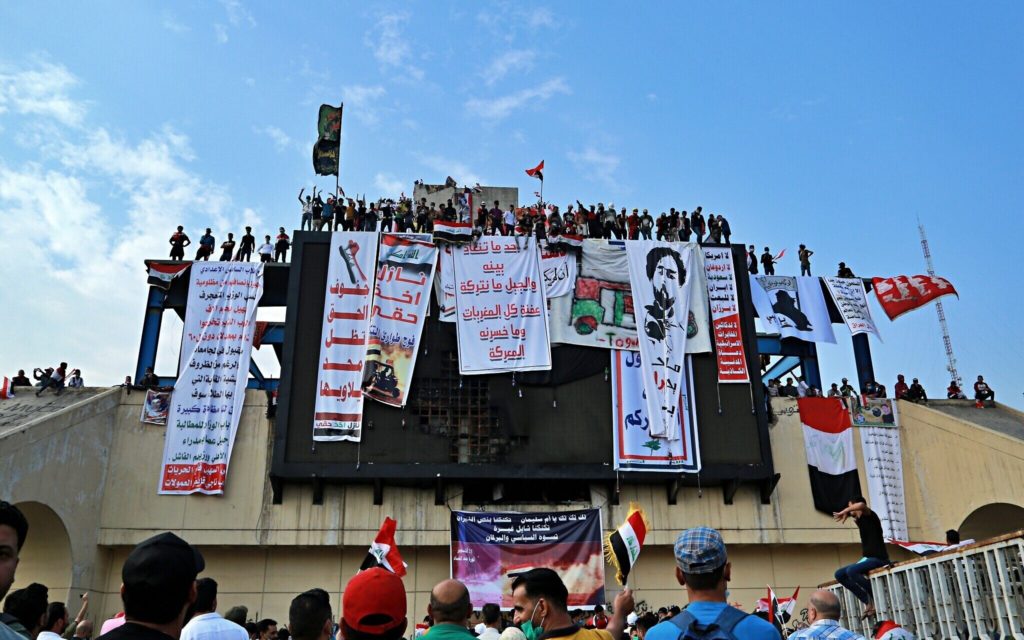
Additional information:
The Turkish Restaurant: a unique place in Baghdad
The Turkish Restaurant is a building now occupied by protesters—keep in mind that the occupation of public or private buildings is not widespread in the Middle East and Iraq. The building itself is a 14-story building built in the 80s during the dictatorship of Saddam; it was initially a shopping mall with a large parking garage and many shops. On the top floor—which opened onto a fantastic panorama of Baghdad—there was a Turkish restaurant. During the reign of Saddam, the building was also used for communications and for this it was bombed by the US in 1991, at least, this was their justification.
Rebuilt in 2001 and then inaugurated as the home of the government’s Ministry of Sport and Youth, it was bombed again by US tanks during the 2003 invasion.
For a time, at the beginning of the demonstrations, militias used expert snipers to shoot at demonstrations, killing several people. These snipers were placed on the tallest buildings, one of which was the Turkish Restaurant, located next to the Jumurrya Bridge from where one can control all of Tahrir Square. Given this strategic position, young protesters decided to occupy the building, careful to check first that it was no longer being used by snipers and police as a base to act against them. Gradually it became a powerful symbol of the demonstrations: from there protesters could display their slogans for all to see, towards Tahrir Square, towards the other side of the bridge, and also towards the Green Zone and other government buildings. The building became a platform, broadcasting the movement’s many slogans, a place for protesters to report their political aims and goals. As mentioned above, the building had been bombed again during the occupation of 2003 and since then it remained abandoned, a symbol of the failure of subsequent governments who were never able to carry out the reconstruction expected by the Iraqis.
This historical background of the “Turkish Restaurant” forms a part of the base of its occupation by so many young Iraqis, and also helps to explain why it has become an important symbol and place of resistance. Young demonstrators renamed it Mount Uhud, the site of a battle between Muslims following the Prophet Muhammad and other tribes in the area. The youth who spearheaded and continue to perpetuate this movement have decided to stay in the building — and to date they are managing it beautifully. They have cleaned, whitewashed, reinstated the electricity and internet. They even restored the lift and organized surveillance shifts to ensure that the building is never abandoned. They have successfully warded off threats from the police who cross the bridge and avoided potential infiltration from militias and other factions.
In fact, some of those people intent on disrupting the aims of the peaceful protesters have sent unarmed men to try to control the building and to rid it of those they dislike—as happened in another area of Baghdad, in Senek. There, a massacre occurred when demonstrators resisted unarmed men who were in fact linked to militias. When these deceptive men found themselves surrounded, they called on armed militiamen who fired on the demonstrators, killing many of them.
In order to prevent this happening again, checks are now conducted that carefully regulate who can enter the building. One should also note the strategy, especially prominent among Islamist parties, of accusing protesters of smoking, drinking alcohol and bringing girls into the building. This is a deliberate attempt to mislead and misrepresent, it is a concerted effort to delegitimize peaceful protesters in front of a traditional culture and people.
Equally important and equally harmful, this dishonest tactic also serves to threaten the young women who are demonstrating. Inside the building, Iraqi youth have organized themselves to make sure that all young women who want to go up to the 14th floor are not threatened. In the presence of thousands of young people, young women report feeling extremely safe. There have been no obvious cases of sexual harassment, which have too often been widespread in similar situations concerning questions of freedom of expression for women. Since the start of the demonstrations, people have reported that Baghdad has never been so safe for young women. Indeed, some have slept in Tahrir Square, and have gone up to the 14th floor to take photos and selfies. This is an important message now emerging from Tahrir Square. For the moment, however, there do not appear to be unmixed, feminine/feminist groups, apart from those made up of female students from the same school (who are separate from students at all male ones).

